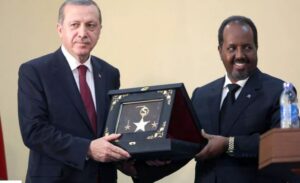Somalia’s counter-terrorism policy may be stifling the media reporting against violent extremism, a study released on Thursday says.
The report further suggests areas to rope in more positive messaging to tame the vice.
An analysis of the existing Federal Government of Somalia National Strategy for Preventing and Countering Violent Extremism, a 2016 policy, showed that while the public generally supports the government in taming terror merchants, a significant section of the population may be lagging behind because the media messaging for them is either lacking or non-existent.
This is because the framing of the content presented to the public is either in a language locals don’t understand or is too generic or ambiguous, something that may be dragging the government’s efforts in fighting extremism.
“It is worth emphasising that the content of the strategy and the way in which the content is presented are critical for media analysis and interpretation.
“When information is either missing or is presented in a way that is open to misinterpretation, there is a far greater risk of inaccuracies in media coverage and framing,” say findings of a report titled A Critical Analysis of Somalia’s National Strategy On P/CVE: A Media Perspective.
The study, funded by the Australian Department for Foreign Affairs and Trade (DFAT) and commissioned by the National Union of Somali Journalists (NUSOJ), sought to find the missing links between Somalia’s counterterrorism measures and media reporting of it.
The research and analysis was conducted by Dr James Oranga, from the Department of Journalism and Mass Communications at the University of Nairobi in Kenya.
In most cases, the findings show that the government itself had turned into a tormentor of journalists, detaining or threatening them in their line of work. This is besides the usual threats journalists in Somalia face, such as being targeted by al-Shabaab militants.
The existing counterterrorism strategy may be up for review soon after President Hassan Sheikh Mohamud promised to tighten loopholes that have made it easier for al-Shabaab to thrive, including infiltrating institutions. But one gap that may be addressed, the study says, is how the strategy is communicated to the public.
“The strategy stops short of acknowledging that all efforts to counter radicalisation and violent extremism are actualised or in some way facilitated by communication.
“Besides, extremist groups rely on the publicity afforded by media and, therefore, any effective counterbalance to extremist rhetoric or propaganda must be media-based,” it says.
Somalia’s strategy labels the cause of violent extremism such as poverty, feeling of marginalisation, illiteracy and lack of economic opportunities.
In the recent efforts to tame al-Shabaab, the Federal Government of Somalia banned the media from reporting on Shabaab narratives, encouraged village vigilantes to fight alongside the Somalia National Army, and directed banks and telcos to freeze money transfer accounts linked to al-Shabaab.
The strategy, the study says, should go further and specify how some of the causes of marginalisation, illiteracy or poverty, for instance, can be addressed and proper messaging relayed through the media.
“The answers to such questions would provide greater insight into the underlying drivers of radicalisation and violent extremism, thereby enabling stakeholders to devise holistic solutions, including those recommended by the media in its role as a watchdog of democracy.”
Also read: Somali president urges people to flush out Al-Shabaab ‘bedbugs’
While the strategy breaks down the specified groups considered vulnerable to violent extremism, the gap is that the media haven’t been involved or trained to interpret it for the audiences.
The National Union of Somali Journalists (NUSOJ) says the findings can help policy makers work well with the media in fighting violent extremism as it is journalists who can be better believed to de-radicalise and can “act as counterbalance to the narratives peddled by extremist groups,” a statement from NUSOJ said on Friday.
“Consequently, any strategy, especially one developed by the government, should not fail to prioritise the role of the media in P/CVE (Preventing and countering violent extremism),” said Omar Faruk Osman, NUSOJ Secretary-General.
“Serious consideration should be given to the active involvement of the media in devising and drafting such a strategy since journalists are uniquely placed to ensure that communication priorities are firmly rooted in media practice,” he added in a statement.
The study also recommends the structure and content of the new strategy should be adjusted to make it more accessible to stakeholders who may wish to use it as a point of reference.










